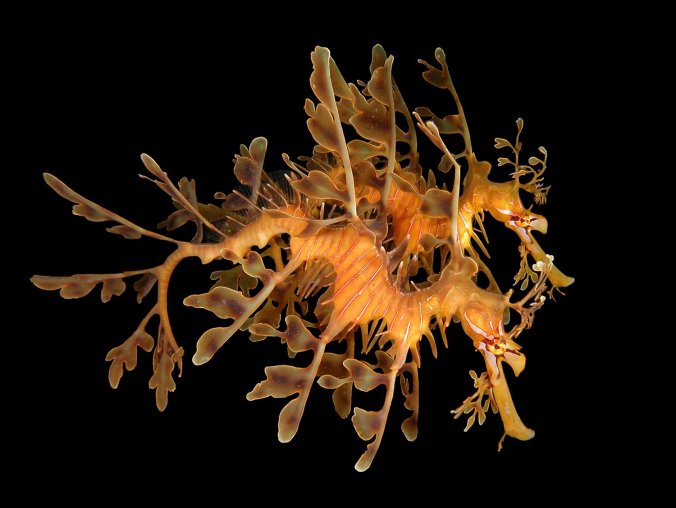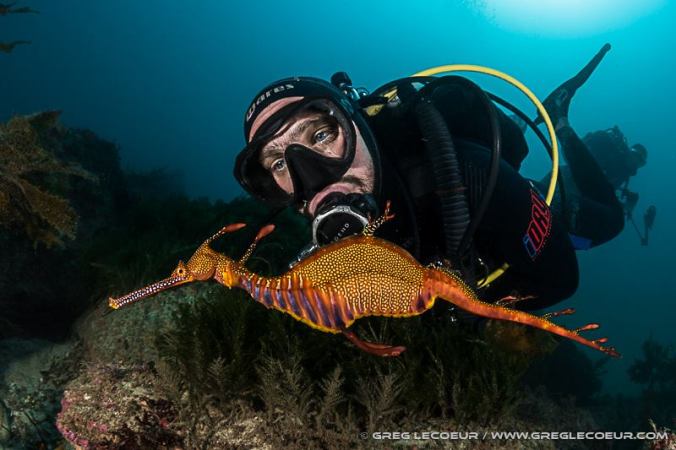In a recent poll organised by the Australian Society for Fish Biology and Lateral Magazine, the Leafy Seadragon (Phycodurus eques) was voted as Australia’s favourite fish. This exquisite critter definitely deserves its place at the top, to celebrate it amazingness I wrote a blog about it. This blog appeared originally as an article in Lateral Magazine, you can find the original version here.
According to the popular stereotype, marine biologists spend their careers diving on colourful coral reefs, cuddling dolphins, and wrestling sharks. Unfortunately, the truth is a lot more mundane; we are more likely to spend our days diving into data analyses, cuddling too many cups of coffee, and wrestling grant proposals.
But sometimes we get lucky enough to work with animals that exceed the wildest stereotypes. Studying marine life is always exciting, but some animals are so unique they just stop you in your tracks; they make you thank your lucky stars for not listening to your mother when she said ‘marine biologist’ was not a real job.

Two leafy seadragons. Photo credit: David Harasti
For me, the ultimate awe-inspiring fish is the leafy seadragon (Phycodurus eques). “Leafies” only occur in temperate waters off southern Australia, and they are, to say the very least, unique animals — the kind that makes you wonder whether evolution had a stroke of brilliance or just a stroke. Seadragons belong to the Syngnathidae family, which also includes seahorses and pipefishes. Even in a family that is known for their oddly-shaped members, leafies stand out big-time.
These beautiful fish have the head of a seahorse and the body of a seaweed, with flamboyant leaf-like protrusions that wouldn’t look out of place at the Carnival in Rio de Janeiro. Leafy seadragons defy the idea of what a fish should look like.
Maybe that is why they are so popular with fish enthusiasts all over the world. Scuba divers fly halfway across the globe to dive in the cold waters off southern Australia, hoping to catch a glimpse of them. In the few public aquaria that display them, including Melbourne Aquarium, leafies are one of the absolute crowd-pleasers. For fish-lovers, this Australian endemic fish is at least as iconic as kangaroos or koalas.

Leafy seadragon. Photo credit: Tony Brown
Despite their popularity, we know surprisingly little about leafy seadragons. Adult leafies are one of the largest members of the Syngnathidae family, with adults measuring up to 35cm. Like seahorses, male seadragons carry their mating partner’s fertilised eggs; unlike seahorses, they do not have a pouch. Instead, females lay their eggs on the underside of the male’s tail, where they remain until hatching.
Leafy seadragons depend on kelp and seagrass beds as their habitat, where they blend in supremely well to avoid predators. Unfortunately, these habitats are in decline all over the world, including in Australia, caused by coastal development and potentially climate change. As a result, seadragon population numbers are decreasing, although the species is currently not considered to be endangered.

Admiring a Weedy seadragon, a close cousin of the Leafy seadragon. Photo credit: Greg Lecoeur
One would assume that the decreasing population numbers of a unique Australian emblem would inspire multitudes of researchers to study it. Strangely, this is not the case. A search of the scientific literature suggests that nobody has studied them in the wild for almost a decade. This lack of research on evolutionary distinct marine critters is unfortunately not unique to seadragons. It extends to many other species that do not fit in the ‘food’, ‘danger’, or ‘Pixar-famous’ categories in which landlubbers like to divide marine life. If so little attention is paid to the struggles of Australia’s most recognisable and charismatic fish, then what hope do other species have?
Time will tell what the future holds for the leafy seadragon. I, for one, am doing what I can to ensure generations after ours will continue to have their minds boggled by this incredible animal. If you care about seadragons, one way to help is to join citizen science projects such as iNaturalist or Seagrass Spotter. These projects collect observations from divers and snorkellers, directly helping scientists better understand and protect these animals and their habitats.
A short note about this blog: Two weeks after the poll I was awarded a research grant by the Sea World Research and Rescue Foundation to study the seadragons using eDNA. Hopefully the results that will come out of this research will help to better understand and protect these beautiful fishes.
Congratulations on your grant!!!
LikeLike
Thank you!
LikeLike
Pingback: Chasing the seadragon | Critter Research
Pingback: The plight of Tasmania’s handfish | Critter Research